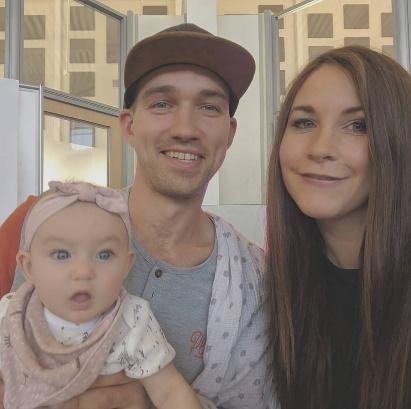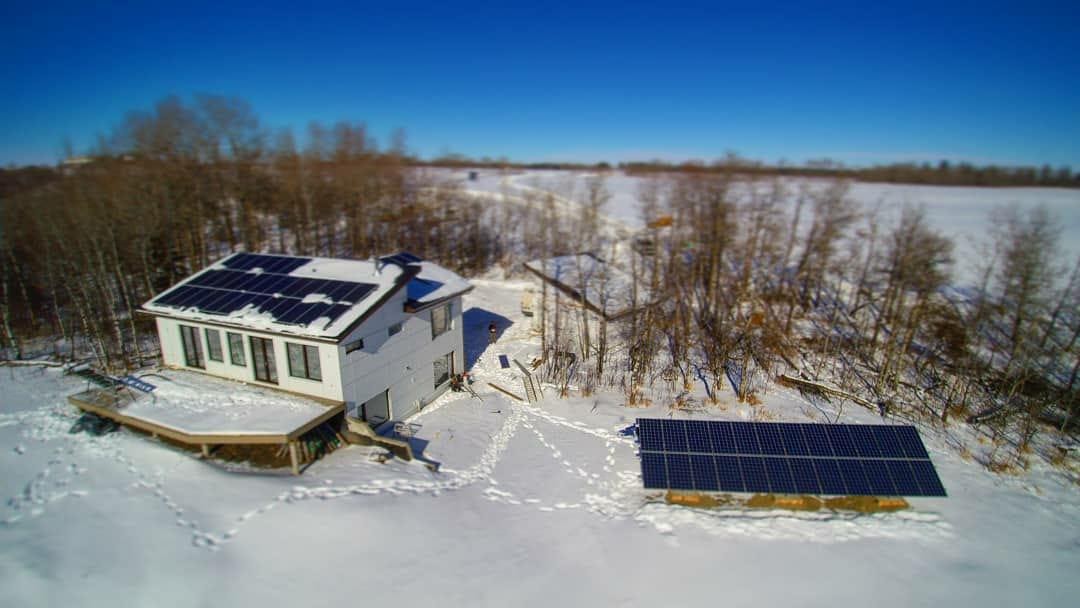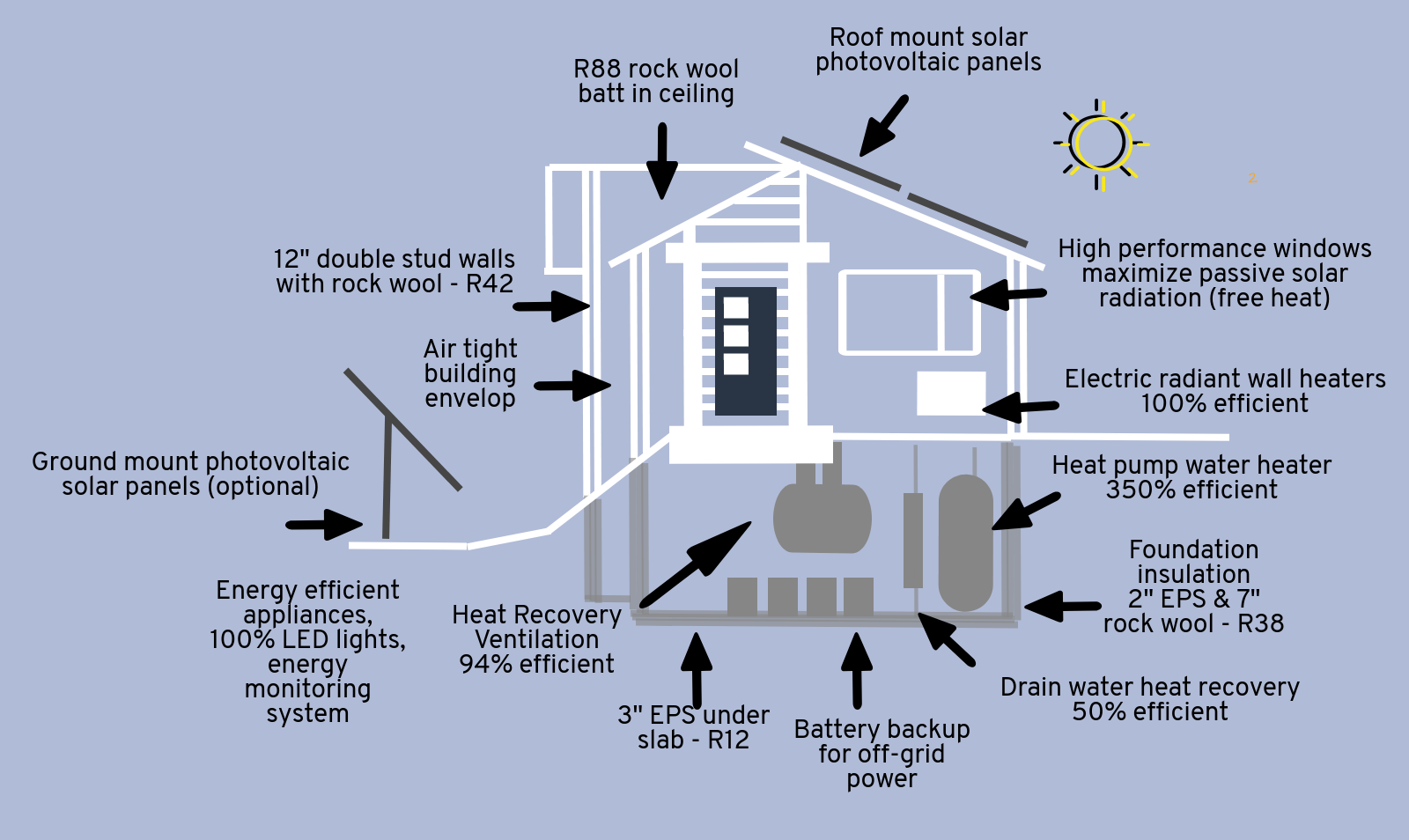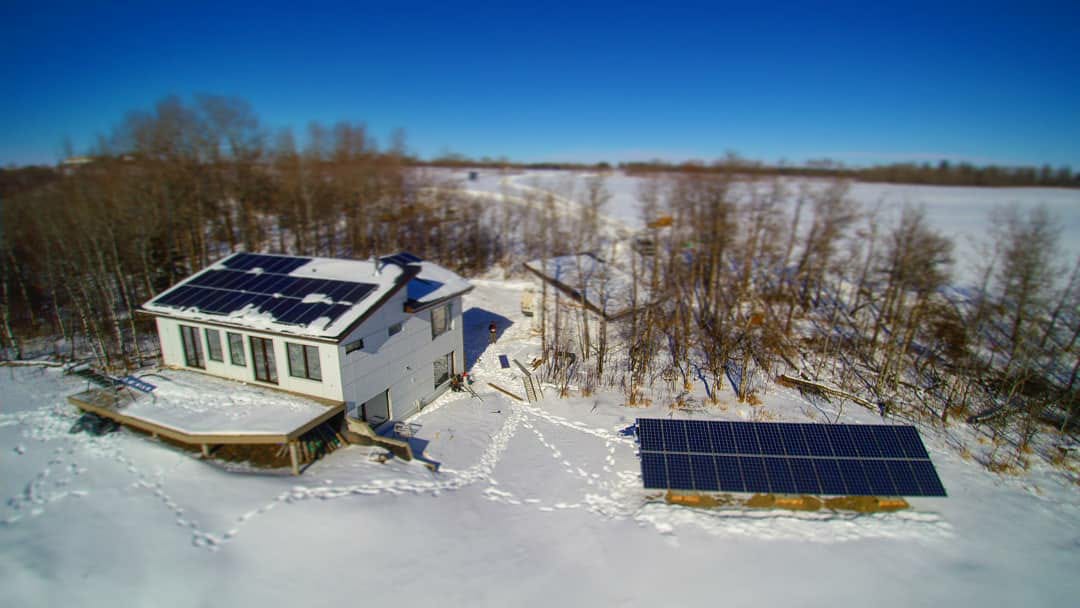By: Deanna McArthur

At first glance, Chelsah Thomas seems like your everyday Albertan. The 34-year-old new mother lives in Red Deer with her husband Jesse, who has a background in construction.
Together, they built the home of their dreams, set against the river valley and surrounded by a thick patch of deciduous trees.
It only takes about five minutes with Chelsah before you get a feel for the passion, and depth of knowledge she has about energy efficiency and passive home construction.
Chelsah has a masters in Environmental Management with a focus on solar energy from Western State Colorado University. Today, together with her husband, she runs Sol Invictus Energy Services Ltd. (SIES), a socially responsible energy solution company.
That dream home she and her husband built together (The Thomas House) was Central Alberta’s first contemporary Passive, Net Zero (NZE) home.
Passive homes follow a German design standard that utilizes design materials and orientation in order to reduce a buildings ecological footprint. These ultra low energy buildings require little energy for space heating or cooling.
The Thomas House was what led Chelsah to build SIES into the company that it is today.
“The initial vision was to build a solar company with a social aspect to it,” said Chelsah. “But when we started thinking about building a Net Zero/Passive house, we couldn’t find any local consultants to help us with the process.”
Chelsah took matters into her own hands and completed a passive house design course. She is now a certified Energy Adviser through Natural Resources Canada. Together with the help of another consultant with passive house design experience, Bow Crow Design, they designed and built their home themselves.
“Working on our own home made me realize how much I enjoyed working with residential energy and high-performance homes,” said Chelsah. “So, I decided to transfer the foundation of my company from solar to residential energy efficiency.”
The “Damn Near Passive” House

It took three years from concept to completion. The finishing touches on the Thomas House were completed in May of 2018 and Chelsah says they hope it can be used as an example for others looking to go the same route.
“We are hoping to use our house as a demo site for Albertans to see that a high-performance home is logistically and economically feasible in Central Alberta.”
Built into a hill, and with a walkout basement, the home is surrounded by deciduous trees, which allows for passive solar energy gain to be maximized during the winter, and be shaded from the sun during the summer.
Some of the features of the home include:
- Two separate solar systems, a 12-kWh grid tied solar photovoltaic system and a 6 kWh off-grid battery backup solar PV system.
- High performance heat recovery ventilator that meets Passive House standards. This brings in pre-warmed fresh air with a high MERV filter to filter out pollen, dust, smoke, exhaust allergens, and more, which increases the indoor air quality.
- High efficiency heat pump hot water tank which is 350% efficient and uses indoor air to heat the water. With WIFI connection and a built in application, it can be controlled wirelessly and it is easy to monitor its energy consumption.
- Powerpipe drain water heat recovery system installed to recover 53% of heat energy from shower and appliance wastewater, transferring the energy back into the hot water tank, reducing energy requirements and saving on energy costs.
- LED lights.
- High efficiency “smart” appliances that can be managed remotely through apps. Appliances can be set to turn on during high solar times, rather than using grid electricity.
- Smappee Energy Monitoring system which shows in real time, the homes consumption and generation, including utility costs associated with consumption.
- High efficiency windows that meet Passive House standards
- Recycled rubber roofing.
- High efficiency toilets offering 20% water savings.
- Passive house cat door with a magnetic airtight and weatherproof seal.

Now that construction has been completed and winter has passed, Chelsah says they are now focusing on completing some exterior work. The landscaping will include a holistic permaculture approach to sustainability where they can maximize ecosystem services provided by the landscape.
“We are planning to utilize xeriscaping, which is a landscaping philosophy that uses as many native, drought-resistant plants as possible to help limit our water use. We also have plans to utilize vermiculture, grow fruits and veggies on site, and a little further in the future, raise chickens.”
Although it doesn’t quite make the cut to be fully certified as a passive house, Chelsah is proud of their “damn near passive home” which has a total energy load that is about 64% less than a conventional home and a heating load 77% less. The house is so energy efficient, you could almost heat it with a blow dryer.
Plus, with the added solar systems, Chelsah expects that their home will actually be net positive, meaning it is so efficient it produces more energy than it consumes.
Chelsah has joined the Solar Club, like the one offered by Park Power. This electricity rate plan and loyalty program helps her maximize the benefits she receives from her solar system.
“It is important to find a way to maximize the benefits of solar energy financially, both for ourselves and our clients, so that the cost of building a net zero home is offset by lower energy costs,” she said.
“We were looking to make more money on energy exported to the grid, and we found Spot Power’s 18.75 cent/kWh rate. Utilizing this rate in the summer and then switching to the lower rate at the end of October just makes financial sense. I have estimated that the Solar Club could save the clients of one of our projects hundreds of dollars a year.”
The Thomas House vs the Alberta Winter
How does a home like this hold up against the harsh Alberta winters? This years bitingly cold February was a perfect opportunity to test the performance of the design.
“I have to be honest, the motherly instinct in me was a little apprehensive when the cold winter weather started rolling in,” said Chelsah. “The home has no furnace, and I had a new baby. Were we going to be able to stay warm?”
“It can be scary in Alberta to not be on the grid as far as natural gas, because that does feel like a constant secure access to energy,” she added. “But we made it! We were comfortable and we were warm.”
Normal winter conditions in Central Alberta have an average temperature that ranges between -2⁰ to -16⁰ Celsius. During these regular days, the home maintained a very comfortable living temperature with little effort.
The high levels of insulation, with limited heat loss through air leakage, and passive solar heat gains, all contributed to the minimal temperature fluctuations in the home. Although, additional heat in the form of a small radiant electric heater was required in order to “top up” the heat, especially at night, while some days they used a wood stove for heat.
Benefits of Passive House Design
The benefits of a green home go far beyond just energy savings, according to Chelsah. These types of homes also:
- Have cleaner indoor air quality because of their use of heat recovery ventilators. These filter air as it comes into the house, which removes allergens, toxins and pollution.
- Use low Volatile Organic Compound (VOC) paint and adhesives. VOCs are found in many building materials. These chemicals let off gasses that are harmful to people and the environment and can contribute to health problems.
- Are more comfortable. Since they are well insulated and practically airtight, they maintain indoor air temperature more regularly and you don’t feel the drafts you would in a typical home.
- Have higher resale value. Net Zero homes receive a 4-10% premium when they are resold. Buyers recognize that these homes have higher construction quality, and come with other added benefits such as continuous energy production.
- Are more resilient. The environment in the home is regulated so well you don’t feel the effects of day to day weather fluctuations as much as you would in other homes.
“Even our solar panels are resilient,” said Chelsah. “We have had some major hail storms, and our solar system remains damage free, while our family wrote off four vehicles.”
Engaging More Homeowners in Alberta
According to Chelsah, passive home design is not well known in Alberta.
“Most people assume that how homes are constructed in Alberta is the best way it can be done,” she said. “But that is not necessarily the case. Most are building to a minimum code standard, which is not doing anyone any favours in relation to efficiency.”
With any new technology, it takes time to catch on with consumers.
Chelsah hopes that SIES will not only be able to help spread the word and guide Albertans through the journey of building a high-performance home, but will also develop a network of like-minded professionals in Alberta to create a hub for high-performance home design and solar professionals in Alberta.
“Building a community of professionals will allow us to share information and best practices with each other, benefiting the industry and consumers overall. It is also essential that the professional community is educating people on energy consumption and increase the overall energy literacy of Alberta.”
To learn more about Sol Invictus Energy Services Ltd. and eco-homes visit solinvictusenergyservices.com.



Leave a Reply